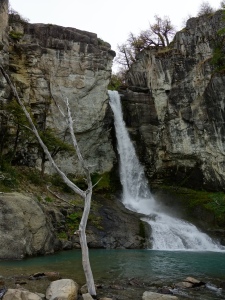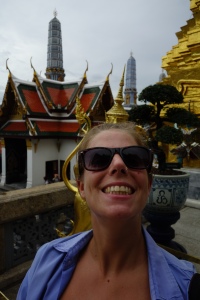El Calafate had been about the Perito Moreno Glacier, pretty much. El Chaltén is about hiking, and about Fitz Roy – a particularly famously picturesque and – for climbers – difficult mountain in the southern Andes. (It may also have been a bit about cheap sugary pastry things from the bakeries, and about the DVDs of live rock concerts favoured by our host at our excellent hostel, Albergue Aylen-Aike.)

Mount Fitz Roy (right), seen from the end of the hike out to Laguna de los Tres
Hiking is a big deal in Patagonia. Trekkers come from far flung places, armed with The North Face this, Kathmandu that and Colombia the other, bearing tents and sleeping bags and walking poles and sturdy boots, and sporting more layers of clothing than I have pairs of socks. (I saw one couple pause in the sunshine to shed some of their skins at one point: they each took off two jackets, a tshirt and then a long-sleeved tshirt, to get down to their innermost tshirt, before putting one of the jackets back on. I was wearing a thin woollen tshirt at the time, and had only just stopped sweating from the climb up the hill. I have no idea how they weren’t drowning in a sea of their own perspiration. Seriously, someone from some deodorant company needs to get in touch with these guys and sign them up as advertising models.)
We weren’t quite so thoroughly outfitted as many of the travellers around us. (Including one Eastern European group who’d also been on our Big Ice tour in El Calafate, and whom I took great pleasure in naming the “Poles with poles,” in a joke that was apparently much funnier to me than to anybody else.) In particular, we weren’t set up to do any camping, so absent a strong desire to go hire a whole bunch of stuff to allow us to sleep less comfortably than we otherwise would in, y’know, a bed, we were restricted to the day hikes. No five-day ‘the W’ Torres del Paine trek out of El Calafate for us, nor the two-day trek to Laguna Torre out of El Chaltén. (Though in fairness, we confidently assured ourselves that we probably could have quick-marched the latter in a single day had we anticipated seeing anything particularly interesting at the other end of it.)
But nonetheless, El Chaltén offers a fair number of day hikes, and some beautiful scenery for them, so having lazily used up a whole day for the three hour bus ride from El Calafate (it’s alright, the weather was shit that day anyway), we set about planning how much of the area we could traverse in the time we had available.

A slightly more distant – but cloudless – view of Mount Fitz Roy, from partway along the trail out to Mirador Loma del Pliegue Tumbado
Nearly all the treks in the area focus on getting a good view of Fitz Roy and/or its glaciers. The problem with this is that Fitz Roy is, like Everest, quite often entombed in cloud. Thankfully, Sebastian, the ever-helpful rock-DVD-loving owner of our hostel, was armed with weather forecasts and excellent advice. Don’t do the Laguna de los Tres hike first, he said (this is the hike that is most specifically pointed to a front-and-centre prime viewing of Fitz Roy), do the Piedras Blancas one instead (a hike that ends over a lot of large boulders – the piedras blancas, or white rocks – to a nearby glacier, Glacier Fitz Roy East, aka Glacier Piedras Blancas). The weather’s supposed to clear up in the afternoon, so if it looks clear once you’re done, then you can whip up to Laguna de los Tres. And if it doesn’t, you can do that tomorrow, when the weather’s better. Anyway, almost no one goes to Piedras Blancas, which is a pity, coz it’s cool.
So Piedras Blancas it was. And it was cool. First, we got to climb over big rocks. And because we’re apparently about nine years old on the inside, that was fun just by itself.

Look, ma! Check out this picture of me on this big rock I climbed!
And second, the glacier was really awesome. It’s on a rocky mountainside, and so rather than just being a big wide flat sheet of white, it’s carved out in a more interesting shape by the protrusions of the rock beneath. And more than that, it has waterfalls. There were several, but the most impressive was a huge cascade running down the right hand side of the glacier. I don’t know why, but to me the fact of a glacier having a huge gushing waterfall is in itself very cool. But cool was not sufficient. This waterfall was alive. Every ten or fifteen minutes we’d hear crashes and quickly look up to the waterfall. Sometimes you’d just see a little more water pouring out, or watch as the waterfall changed course slightly, reminding you just how dynamic a glacier really is. But sometimes you’d look up to see a cavalcade of ice tumbling down, the waterfall doubling or tripling in size and ferocity, sending large chunks of previously immovable glacier down into the lake as well as a torrent of water. You’d see the waterfall seek out new, additional courses downwards, as the normal route filled and overflowed around the frozen barrier under which it normally fitted just fine. And you’d sit and watch as everything slowly returned to normal, waiting for the next several tonnes of ice to break off a little later, just as thunderously, leaving just as little visible impact on the imposing façade that remained behind.

Glacier Piedras Blancas, with awesome waterfall on the right hand side
It was impressive stuff. And Sebastian was right – almost no one else ventures out to Piedras Blancas (at least, not the whole way out – quite a few turn back once the boulder-bashing begins), and so we had the whole spectacle to ourselves.
The weather forecast was right, too. The cloud cleared up some in the mid-afternoon, so by the time we were heading back from our glacier-watching, Fitz Roy was clear, and the climb up to Laguna de los Tres would be worthwhile. Excellent.
Admittedly, it was an energy-sapping climb: normally I’m the annoying git eagerly suggesting that whatever random direction has a bit more uphill is probably the more entertaining option, but this one had my legs a little tired, especially after the boulders at Piedras Blancas and the scramble up the ridge thereafter. But while it might have been steep and long, it was also straightforward, and we made it to the top in about an hour. Which meant were there for some good photos before and after the sun disappeared behind a mountain at 6.15pm.

The view from Laguna de los Tres
Laguna de los Tres is apparently thusly named with ‘los Tres’ referring to the three peaks in front of you at the top: Fitz Roy, Poincenot and Saint-Exupéry. We got our fill of viewing those before we started our descent and turned for home (finally leaving the trail by the light of a brilliant full moon, just after the sun had set). It had been a good day, all up – 36km walked, in about ten or eleven hours – and we felt satisfyingly tired. We also felt not a lot like making many decisions for dinner. So we went back to the same place as the previous night – La Brasería – and I enjoyed exactly the same meal I’d had roughly 23h earlier: an awesome steak, topped with bacon, and with a side of eggs fried/poached in half a capsicum. (Don’t worry Mum, there was a hearty salad in there too, as well as the plate of French fries.)
The next day we had a bit of a rest: only 16km of hiking, to the two lookouts named Los Condores and Las Águilas, plus a waterfall a bit north of town (Chorrillo del Salto). Nice and easy walks, although there was nothing particularly fascinating about them (we saw neither condors nor eagles at the lookouts, although you’ll be pleased to know that we did indeed see a waterfall at the waterfall).

Chorrillo del Salto
On our final full day, we had another long hike: this time out to Mirador Loma del Pleigue Tumbado. This is the go-to panorama site for a view of all of Fitz Roy and its surrounds. Pleasantly, this one delivered at least one condor.

A condor flying high on an updraft over the mountains, seen from Mirador Loma del Pliegue Tumbado, looking towards Mount Fitz Roy (which is out of the shot to the right of the photo)
And it was a very pretty hike through the woods to get there, too, and a rewarding vista at the end.

A view we were getting used to: Mount Fitz Roy and its surrounds, here seen from Mirador Loma del Pliegue Tumbado
After that hike, all that was left was to head back and try another recommended local restaurant. And to try a bit more of the local wine – including a sample of the local Tetrapak-encased fare, ‘Termidor’. A sample which had us wanting our £3 back. We were particularly unimpressed to discover that Sebastian had been very accurate in describing it as uncannily like gasoline. Thank god we had back-ups: a couple of much more palatable bottles of the local good stuff.
Then, although we had a couple of days to spare before we flew out of Patagonia, it was back to El Calafate: the internet is better there, and we had millions of photos to sort through and back up. That and a few pairs of very smelly socks to wash.
































